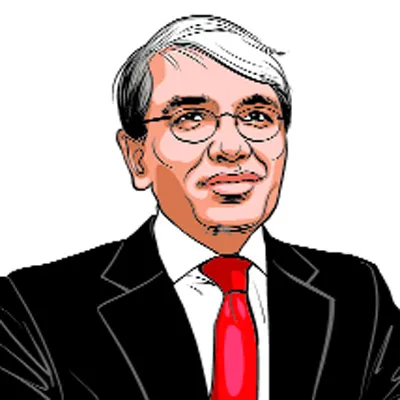Opinion EPFO changes will enhance social security
They also lay the foundations for EPFO to morph from an isolated employer instrument into a lifetime
 EPFO has unveiled a series of reforms to make it easier for its members to dip into their corpus. Do these measures sacrifice security for flexibility? (Illustration by C R Sasikumar)
EPFO has unveiled a series of reforms to make it easier for its members to dip into their corpus. Do these measures sacrifice security for flexibility? (Illustration by C R Sasikumar) The global challenges of financing pensions arise from ageing but reflect individual pathologies: Europe needs to invest more, America needs to save more, and China needs to consume more. India needs all three, and well-designed pensions will enhance public finances, accelerate the creation of formal non-farm jobs, and deepen domestic investment pools. Recent changes by the Employees’ Provident Fund Organisation (EPFO) represent a bold shift from control to trust, enabling future pension reform, especially in balance portability, employee choice, and NPS competition, facilitating lifetime, Aadhaar-linked Citizen Social Security Accounts (CSSA).
Pensions have three pillars: Government, individuals and employers. The first pillar began in Germany under Otto von Bismarck, with pensions promised at nearly twice the life expectancy. However, today, some European governments start public pensions at almost half of life expectancy. These unfunded promises — off-balance-sheet debt — represent tomorrow’s taxes or inflation. With India’s public debt approaching 85 per cent of GDP, government-funded pensions are unaffordable. EPFO must strengthen the employer pillar — particularly among MSMEs — with seamless balance portability across jobs, legislating the optimal amount of mandatory salary confiscation before which informal employment becomes attractive, and encouraging competition to lower administrative costs and improve customer satisfaction.
EPFO’s reforms cover five areas. They consolidate 13 withdrawal categories into three: essential needs (education, marriage, medical emergencies), housing (purchase or construction), and special circumstances (retirement, disability, retrenchment, voluntary retirement, or relocation abroad). They revisit withdrawal limits for partial (capped at 75 per cent) and complete (for retirement, permanent disability or permanent relocation abroad). They use insights from behavioural science to mitigate impulsiveness by increasing the waiting period for defined contribution balances after a job from two to 12 months and for defined benefit balances from two to 36 months. They ensure sustainability and compounding by mandating a minimum balance of 25 per cent. They are a step towards building a digital public infrastructure with auto-settlement of claims up to Rs 5 lakh, unified passbook access and digital life certificates for pensioners. These will raise EPFO efficiency, satisfaction and effectiveness.
They also lay the foundations for EPFO to morph from an isolated employer instrument into a lifetime, Aadhaar-linked CSSA, which can receive contributions from the government, employers, and individuals for life. CSSA requires three more reforms by EPFO:
NPS competition: EPFO is the world’s costliest government securities mutual fund; its charges of 4 per cent of contributions recovered from employers are 10 times what an equivalent fund from SBI will charge. Instead of reducing costs with scale, EPFO suffers from the cost disease identified by economist William Baumol. Its monopoly creates hostages, not clients, with toxic consequences for employees (disrespect and poor service), small employers (high costs), large employers (everybody has a PF consultant with “good relations”), and society (making informality more lucrative than formality). EPFO currently combines policymaker, regulator, and service provider roles; the benefits of separating these three are demonstrated by the price and service revolution in petroleum, telecom, digital payments, and airlines since 1991. Employees (not employers) must get a choice on paying their contributions to EPFO or NPS. This selection at the time of joining could be changed annually with seamless interoperability between the two, replicating the relationship of our two equity depositories.
Employee Choice: Salary is the property of employees, and the myopic argument of “protecting them from themselves” is unfair. The legislatively prescribed gap between haath waali (net) salary and chitthi waali (gross) salary in a cost-to-company world is unrealistic, with mandatory deductions/costs of approximately 35 per cent for a Rs 5,500 monthly salary and 5 per cent for a Rs 55,000 monthly salary. The savings rate for individuals with incomes of Rs 25,000 per month is close to zero. Similar to the proposed EPFO or NPS provider choice, employees (not employers) must be allowed to choose whether to make contributions (12 per cent) and opt out of diverting part of their employer contribution (8.33 per cent out of 12 per cent) to the defined benefit EPS.
Balance Portability: Employment has shifted from being a lifetime contract to a taxicab relationship; most careers today involve more than five employers. EPFO has a design birth defect that links balances to employers rather than employees; this has created crores of orphaned accounts with unclaimed funds. Providing employees with the option to link their EPFO balance to their Aadhaar number will enhance traceability, portability, and access. This is a prerequisite for including self-employed, farm and gig workers in EPFO.
In 1999, the last NDA government bravely introduced NPS and reformed fiscally unsustainable civil service pensions. A quarter century later, this virasat must be carried forward by targeting universal social security by India@100 through converging EPFO, NPS, Atal Pension Yojana (APY), Pradhan Mantri Shram Yogi Maan-Dhan (PM-SYM), Pradhan Mantri Vaya Vandana Yojana (PMVVY) and the Senior Citizens Savings Scheme (SCSS) to create CSSA.
In 1949, Constituent Assembly member K T Shah worried about social security classification as a directive principle — not a fundamental right — suggesting, “We need a time limit for directive principles to be justiciable”. Prime Minister Jawaharlal Nehru responded, “We cannot have a welfare state unless our national income goes up. India has no existing wealth for you to divide; there is only poverty.” The most effective economic policy for India to deliver mass prosperity and universal social security is massive non-farm, formal, private job creation. EPFO can help this mission by creating lifelong Aadhaar-linked CSSAs.
The writer is with Teamlease Services





